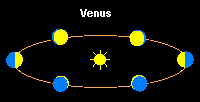 |
The crucial point is the empirical fact that Venus is never very far from the Sun in our sky (see aspects & phases of the inferior planets). Thus, as the enlarged image indicates, in the Ptolemaic system Venus should always be in crescent phase as viewed from the Earth because as it moves around its epicycle it can never be far from the direction of the sun (which lies beyond it), but in the Copernican system Venus should exhibit a complete set of
It is important to note that this was the first empirical evidence (coming almost a century after Copernicus) that allowed a definitive test of the two models — by comparing the predictions of the models with observations. Until that point, both the Ptolemaic and Copernican models described the available data. The primary attraction of the Copernican system was that it described the data in a simpler fashion, but here finally was conclusive evidence that, not only was the Ptolemaic universe more complicated, it also was incorrect.